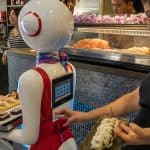Science has slowly been catching up with science fiction, and robots are becoming an increasingly real presence in our world. They’re making important contributions in a wide range of applications including manufacturing, earth and space exploration, weaponry, and even surgery.
But are robots poised to make a power play in the restaurant industry?
Let’s find out.
The earliest robots in foodservice
The short answer is, they’re already here. And they have been for quite a while, though not necessarily in the human-shaped form you might be visualizing. It all started with cobots.
Cobots are the basis for the spread of the automats of the 1970s, and they might be better known by the term “vending machine.” What is a machine that can take your payment, recognize your menu choice, and provide you with the appropriate ice-cold soda or bag of chips all by itself if not a very simplified form of a robot?
These cobots have been around for decades and have only become more complex with the passage of time as some current restaurants use automated systems to accept diners’ orders and payments and then deliver their meals, all with little or no human staff contact.
Three examples of robots in restaurants
The number of restaurants making use of robotic assistance in one way or another is fast-growing. If you’re wondering just what these mechanical interlopers are capable of, here are a few interesting examples:
Spyce Kitchen: The industry’s first fast-casual restaurant with a robotic kitchen, Spyce Kitchen is located in Boston. Spyce keeps a small staff in an off-site kitchen who prepare the basic ingredients for the restaurant’s fast-casual “bowled” meals (conceived by Chef Daniel Boulud). All of the on-site cooking, however, is done by robots.
Guests order using kiosks, and the robots prepare their meals to order using the human-prepped ingredients. Two in-store humans are also available to put finishing touches on meals and to provide customer service.
Bionic Bar: Ever wonder what happened to the Six Million Dollar Man? Royal Caribbean cruise ships have put his arm to work whipping up custom cocktails for thirsty vacationing passengers. Customers simply scan their ID, place their order, and the robot adds their drink to its queue. A screen displays queued orders along with a progress bar that shows who’s up next. It also keeps you up to date on which ingredient is being added to your cocktail at every point in the mixological process.
Creator: But culinary robots aren’t going to be satisfied with merely preparing meals with human-prepped ingredients. In his youth, the creator of Creator, Alex Vardakostas experienced first hand the monotony of making hundreds of burgers every day. His solution? A fully automated sous chef to take the work off his hands. The creator is more than a glorified burger flipper. It’s a robotic member of the staff capable of crafting burgers from beginning to end by not just cooking the meat but also slicing fresh onions and tomatoes to top off each juicy creation.
Pros and cons
As with anything, there are a number of pros and cons related to the use of robots to replace humans in the process of ordering, preparing, delivering, and taking payment for our meals.
On the plus side, the robotic revolution simplifies the process of preparing restaurant food. Robots follow instructions to the letter, greatly reducing, if not eliminating, the chances of waste, improper portions, and a variety of other variables that can result from human unpredictability.
On the other hand, that “unpredictability” could also be renamed “creativity” With robots, the ability to create new dishes or deliver a surprisingly tasty variation on an old favorite is effectively reduced to zero.
Robots can also give guests a more efficient and unique dining experience. No more waiting for overworked servers to take or deliver your orders, or to take your payment when you’re finished.
For the near future, robotic restaurant staff can also provide a unique experience that serves to bring in new customers wanting in on the Next Big Thing. Robots can also work much longer shifts than their human counterparts, reducing manpower expenses.
Once robotic servers have become more ubiquitous, however, one has to think that in time a restaurant with human staff would provide a more unique and desirable dining experience.
Food for thought.





